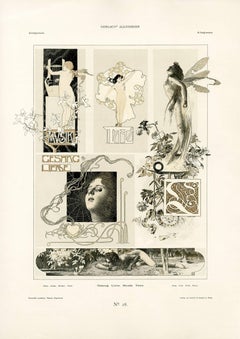Galerie Fledermaus Prints and Multiples
to
77
119
36
3
6
Overall Width
to
Overall Height
to
162
20
2
47
43
34
19
18
40
201
60
82
38
21
136
105
203
118
82
69
69
51
35
29
28
26
26
24
22
15
12
11
11
10
9
8
170
69
5
1
1
31
241
Gerlach's Allegorien Plate #20: "Song, Love, Music, Dance" Lithograph
By Koloman Moser
Located in Chicago, IL
Koloman Moser
(1868 –1918), AUSTRIAN
Instead of applying his flair and art education solely to painting, Koloman Moser embodied the idea of Gesamt Kunstwerk (all-embracing art w...
Category
1890s Vienna Secession Figurative Prints
Materials
Lithograph
